Bar Path Analysis: Maximizing Gains & Enhancing Technique
Author:
Reviewed by:
(21 years of Oly Lifting experience)
Unlock your full potential by engaging with our experts and community! Have questions about your fitness journey or looking for expert advice on weightlifting techniques? Don’t hesitate — leave a comment below and Sergii Putsov will provide a personalized answer and insights to help you reach your goals.
Torokhtiy is reader-supported. Some links are affiliate links, and we may earn a commission at no extra cost to you. See our disclosure page for details.
The bar path in strength sports plays a crucial role in maximizing the performance. From Olympic weightlifting to powerlifting and bodybuilding, understanding the optimal barbell trajectory is essential for athletes.
In this article, we will explore the significance of the bar path, its impact on power transfer and lifting stability and provide insights on analyzing and improving your own movement. Where you are a novice or experienced lifter, mastering the bar path can take your results to new heights.
Bar path in Olympic lifts refers to the trajectory the barbell travels during snatch and clean & jerk exercises. An ideal bar path supposed to be straight and vertical, which optimizes lift efficiency and reduces risk of injuries. It plays a significant role in maximizing performance and achieving proper technique and stability during lifts.
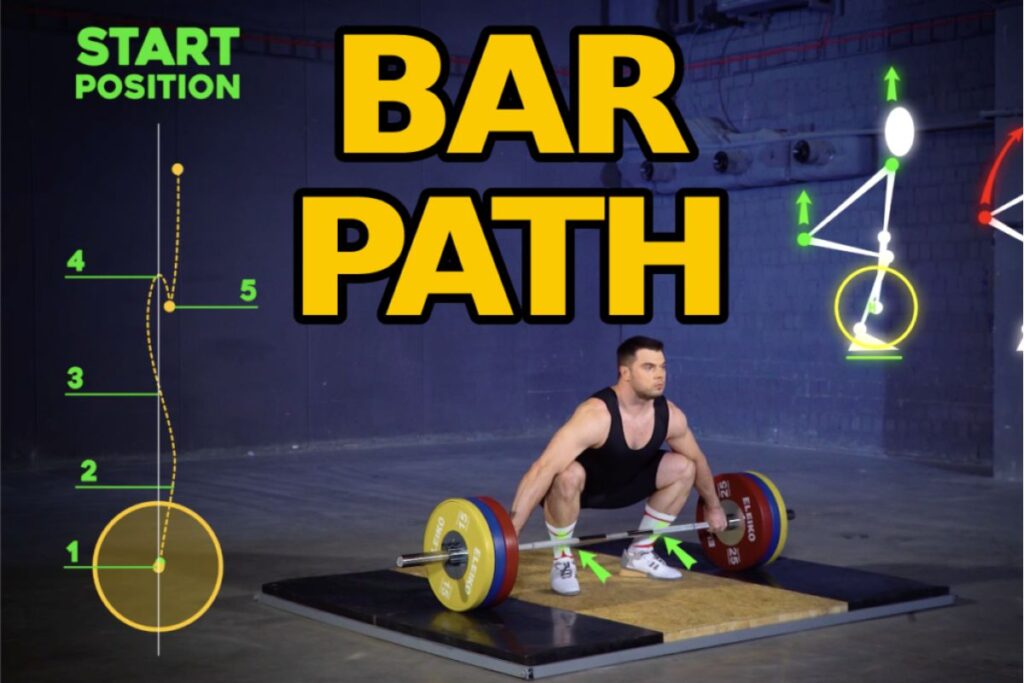
What Is a Bar Path?
Traditionally, the barbell path refers to the specific trajectory of the bar during performing of a lift in strength sports. And if we speak about Olympic weightlifting this is particularly about the snatch and clean and jerk. The bar path determines the lift efficiency and affects the athlete’s ability to complete exercise with heavy weight.
In the ideal world the bar path in the Olympic movements is supposed to be a smooth and vertical line. A vertical path provides weightlifters’ abilities to generatу upward force and this allows transfer the power from leg and back muscles to the bar efficiently. That is why it is so important to build a straight line as close to the body as possible.
Correct barbell path requires from athlete a number of factors:
- technique;
- timing;
- coordination.
It is important to focus on proper positions and applying force with the right vector to ensure the barbell flies with optimal trajectory. This is how you can successfully complete snatch and C&J lifts with the heaviest weight.
Follow us!

Free!
Get a 2-week Weightlifting Program as a bonus for the subscription to kickstart your training plan!

Free!
Why Does Bar Path Matter?
Let’s take a look why does bar path matter in Olympic weightlifting:
1. Efficient Power Transfer
A proper barbell path allows the lifter for the optimal transfer of power from the lifter’s lower body to the barbell. By maintaining a vertical bar path, the lifter can generate maximum force from their legs and hips, effectively transferring that force to the barbell. Any deviations from the optimal path can result in energy loss and reduced performance.
2. Smart Physics Approach
Olympic lifts biomechanics relies on the laws of physics to maximize performance. A vertical barbell path takes advantage of the force of gravity, allowing the athlete to utilize the gravity to assist in driving the weight upward. Even a slight deviation from the vertical path can lead to decreased gravitational assistance and make the lifting way more challenging.
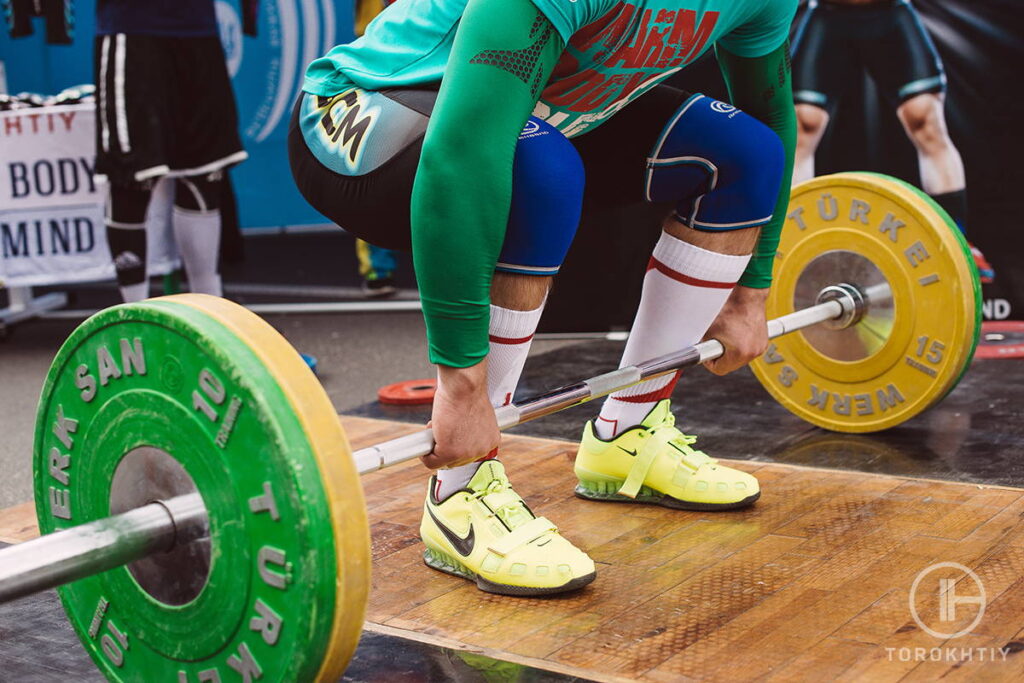
3. Efficiency of Lifting
A correct barbell path helps to lift weights more economically and efficiently. By keeping the barbell close to the body, the lifter minimizes the distance the barbell needs to pass, reducing the amount of muscle work. It also optimize the use of power and strength and allows to engage the muscles in optimal mode.
4. Stability & Technique
Proper technique skills and stability during the snatch and C&J strongly connected with maintaining a consistent barbell path. A stable barbell path helps to maintain control and balance throughout the exercise. It also allows the weightlifter to position their body in the mos advantageous and strong way, and reducing the injury risk and ensuring optimal mechanics.
How to Analyze Bar Path
Now let`s takу a look at steps on how to analyze the barbell path during the lift.
For this we will need to identify specific deviations from the optimal path.
1. Recording of The Video
Today it is very common to use this methoв and film snatch and C&J exercises from different angles. If you perform this with scientific purposes it is recommended to to use few cameras: front, side, 45 angle and reaк views. It is important to find a position where the athlete and the bar are clearly visible for the filming.
2. Key Position Identification
It is useful to analyze key positions throughout the movement where the bar path is crucial, such as the initial (starting) position, the moment it leaves the platform, the position below and above the knees, power position, full extension phase and the catch position overhead in the snatch or front rack position in the clean.
3. Barbell Path Tracking
It is very useful to watch videos of your own lifts in slo-mo or frame by frame focusing on the bar’s movement. Observe any deviations from the optimal path. Look for any backward, forward or lateral movements of the barb that may occur at different parts and stages of the exercise.
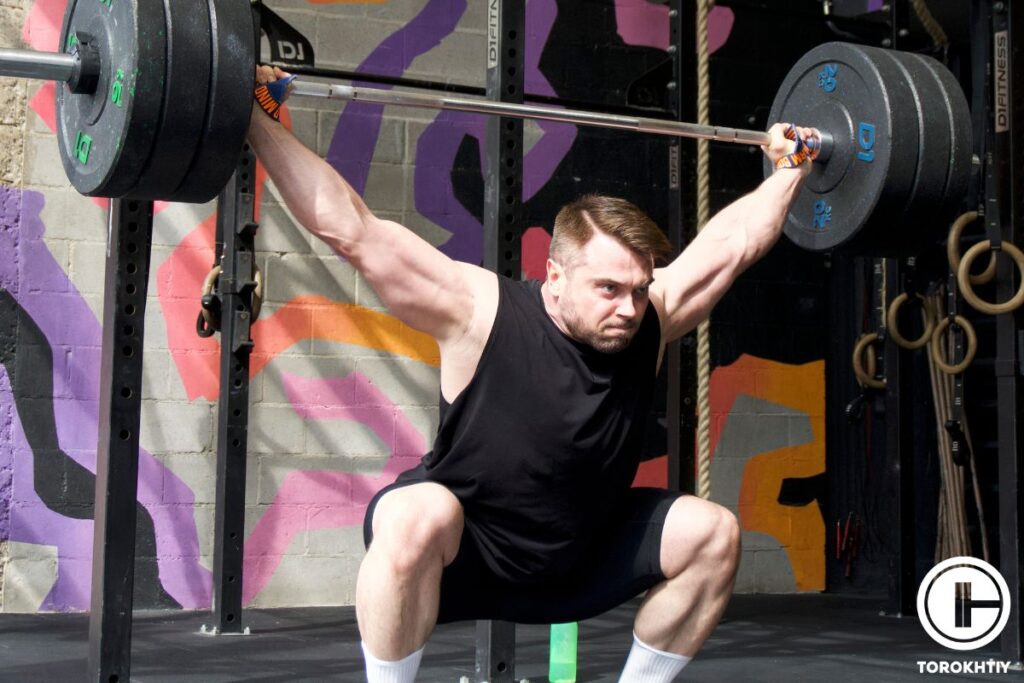
4. Comparison
Study and research science based articles, technical resources, coaching feedback, or videos from top weightlifting competition to develop a clear understanding of the optimal trajectory. Compare yours snatch or C&J bar path in the video with the ideal path to identify any discrepancies.
5. Understand Body Position
Analyzing the barbell path goes hand in hand with assessing the lifter’s movement and body position. Evaluate the athlete’s posture, balance, and weight distribution throughout the movement. Identify any factors that might be influencing the barbell path, such as errors in technique, wrong positioning, lack of mobility or coordination.
6. Expert Detailed Analysis
If you have a chance, don’t hesitate to consult with experienced coaches, scientists or experts who can provide detailed feedback and analysis. You can get valuable insights, identify specific ways or areas for improvement, and find interesting corrective drills to address any bar path issues.
Keep in mind that analyzing the barbell path is a specific skill that requires experience, practice and scientific knowledge of Olympic weightlifting techniques. It can be helpful to attend coaching seminars, study the sport science or seek consultations from qualified coaches to develop your ability to accurately assess and analyze the barbell path.
Bar Path in Weightlifting
In Olympic weightlifting sport, each exercise (snatch, clean, jerk) – has own specific path. Let’s discuss the general characteristics of each exercise.
1. Snatch
During the snatch exercise, the bar path should look slightly S-curve, moving slightly back off the platform, after coming closer to the athlete’s body as it passes the knee level and after power position directing vertically up to overhead position.
It is important to pay attention to 4 most often and common snatch path. Detailed analysis of each will give you understanding that biomechanics is no so easy as it could seems.
Snatch bar path A is the most common. Most weightlifters with this style of snatching tend to perform jump back during the phase of power position. It usually happens because the leg muscles are way stronger than the back. So that is why it is kinda challenging for lifters to apply power vertically.
B path – in this case the barbell directed forward and this can happened due to number of technical mistakes:
- incorrect feet and barbell position in starting position setup, so it leads to move the bar around the shin;
- bad skill in “bringing bar close” due to bad lats engaging;
- inefficient initial motion, due to moving shoulders back.
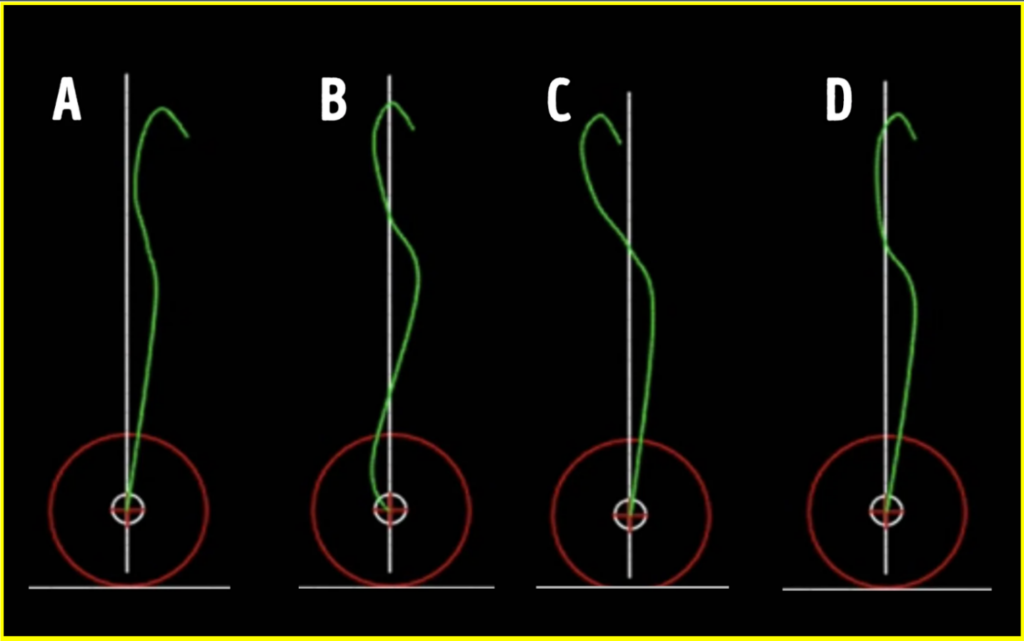
As a consequence – lifters lose power application to wrong angles and leverage.
C path – also known as “novice path”. We can see this trajectory very often when in the second pull and in power position lifter “hits” bar, so it is just moving forward. If it happens, lifter have to step or run forward. Mostly this happens when there is no understanding of the meaning and essence of the idea of power position.
D path – the best name for it is “ideal path.” As we can see in the 1-st and 2-nd Pull barbell is moving to the lifter, after the power position and final extension, the barbell flies vertically up and the catching position is a bit behind the vertical line.
This is a very clear example of how complex and specific could be snatch biomechanical analysis.
2. Clean & Jerk
In the Clean the bar follows almost the similar pattern, but it is shorter. It begins with an initial backward movement off the platform, followed by a close trajectory to the body as it passes the knees. In the second pull, the barbell accelerates upward, and during the jerk phase, it moves vertically overhead. Keep in mind, that power clean bar path will way longer, due to higher catch position.
The Jerk bar path is supposed to look like a vertical line down in the dip and it must be around 8-12% of athlete`s height in the same vertical line till catch position. Also very often we can see when during drive bar trajectory direction can be slightly behind the dip path.
Bar Path in Powerlifting
In powerlifting the bar path definitely differs from Olympic weightlifting due to the mechanic of the involved lifts. Powerlifting consist of three compound lifts: back squat, bench press, deadlift. Here a brief overview of the bar path:
1. Back Squat
The barbell trajectory in this exercise is primarily vertical. Squat bar path moves in a straight line, directly down and up.
2. Bench Press
Bench press bar path is not entirely vertical. It follows a slight backward and forward arc. Arc bench bar path helps to engage more chest and upper body muscles for pressing and lats for stabilization.
3. Deadlift
The barbell path in this exercise is primarily vertical, moving in a straight line up and down. But depending on lifting style (classic or sumo) deadlift bar path can be a bit shorter or longer.
Bar Path in Bodybuilding
The main focus in bodybuilding is not PRs or maximum weight on the bar, it is primarily on development and building muscles and of course aesthetics. That is why bar paths can be different in various exercises and depending on the goals.
So, the barbell trajectory is often customized to emphasize muscle activation and contraction while minimizing stress on other body parts, because the primary focus is to promote muscle growth and aesthetics.
FAQ
What Is the Rule for Bar Lowering in Weightlifting?
After completing the lift on the competition platform and stabilizing body position, the weightlifter must wait for the head referee command. When he hears a specific sound or referee`s voice, he must lower the bar in front of his body on the floor and accompany it with his arms till head level. If an athlete will drop the bar behind the head, it will be considered as “no lift.”
Why Does Bar Path Matter?
The bar path in Olympic weightlifting matters a lot, because it allows for optimal use of technique and efficient power transfer. An efficient bar trajectory enables lifters to generate maximum force, utilize gravitational assistance, and maintain balance and stability and reduce the risk of injury.
Conclusion
So now you will probably agree tha mastering the barbell path is essential for Olympic weightlifters seeking optimal performance and injury prevention. From the snatch to the C&J, understanding and refining bar trajectory can engage right muscles and ensure efficient lifts. And now we would love to hear your thoughts! Share your insights and experiences in the comments below!!!
References:
- A Biomechanical Comparison of Successful and Unsuccessful Snatch Attempts among Elite Male Weightlifters // NCBI: https://www.ncbi.nlm.nih.gov/pmc/articles/PMC6628121/
- Validity and Effects of Placement of Velocity-Based Training Devices // NCBI: https://www.ncbi.nlm.nih.gov/pmc/articles/PMC8472848/
- Comparative 3-dimensional kinematic analysis of snatch technique between top-elite and sub-elite male weightlifters in 69-kg category // NCBI: https://www.ncbi.nlm.nih.gov/pmc/articles/PMC6076374/
- Survey of Barbell Trajectory and Kinematics of the Snatch Lift from the 2015 World and 2017 Pan-American Weightlifting Championships // NCBI: https://www.ncbi.nlm.nih.gov/pmc/articles/PMC7552656/
Why Trust Us?
With over 20 years in Olympic weightlifting, strength training, nutrition coaching, and general fitness our team does its best to provide the audience with ultimate support and meet the needs and requirements of advanced athletes and professional lifters, as well as people who strive to open new opportunities and develop their physical capabilities with us.
By trusting the recommendations of our certified experts in coaching, nutrition, and sports training programming, as well as scientific consultants, and physiotherapists, we provide you with thorough, well-considered, and scientifically proven content. All the information given in the articles concerning workout programming, separate exercises, and athletic performance, in general, is based on verified data.
The product testing process is described in more detail here.
Author: Sergii Putsov
Head of Sport Science, PhD
Best Results: Snatch – 165 kg,
C&J – 200 kg
Sergii Putsov, Ph.D., is a former professional weightlifter and National team member, achieving multiple medals in the 94 kg weight category at national competitions. With a Master’s degree in “Olympic & Professional Sport Training” and a Sport Science Ph.D. from the International Olympic Academy, Greece, Sergii now leads as the Head of Sport Science. He specializes in designing training programs, writing insightful blog articles, providing live commentary at international weightlifting events, and conducting educational seminars worldwide alongside Olympic weightlifting expert Oleksiy Torokhtiy.
Reviewed by: Oleksiy Torokhtiy
Olympic Weightlifting Champion, PhD in Sport Science
Best Results: Snatch – 200 kg,
C&J – 240 kg
Oleksiy Torokhtiy is a professional athlete boasting 20 years of experience in Olympic weightlifting. With multiple European and World titles under his belt, he has showcased his prowess in two Olympic Games (Beijing 2008 and London 2012). Upon concluding his illustrious career, Oleksiy dedicated himself to coaching. By 2022, he had conducted over 200 weightlifting seminars worldwide. He is the visionary behind an international sportswear and accessories brand known for its motto, “Warm Body Cold Mind.” Additionally, he is an esteemed author and the creator of a series of training programs and eBooks.




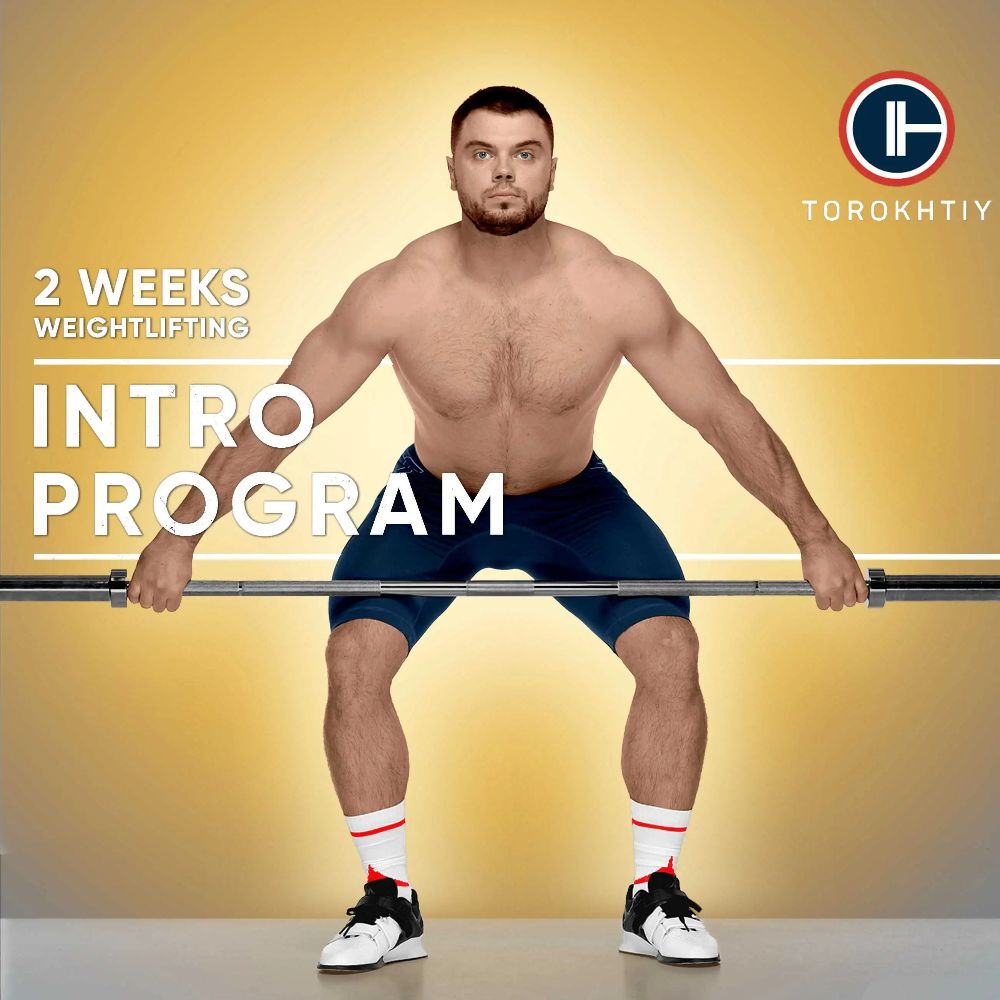
Still have questions after reading our article? Unlock your full potential by engaging with our experts and community! Don’t hesitate — leave a comment below and Sergii Putsov will provide a personalized answer and insights to help you reach your goals.